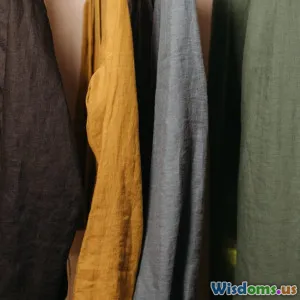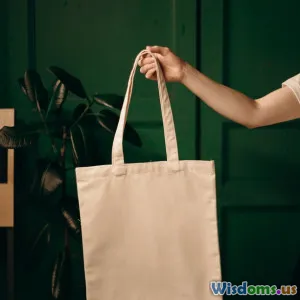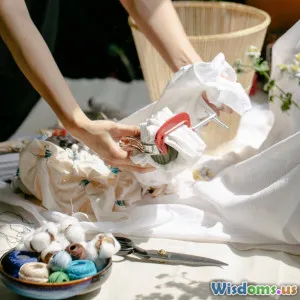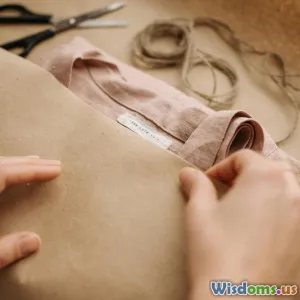
Eco Friendly DIY Ideas
7 min read Discover creative eco-friendly DIY ideas that reduce waste and enhance sustainable living. (0 Reviews)
Eco Friendly DIY Ideas: Creative Ways to Embrace Sustainable Living
In today's world, environmental consciousness is not just a trend but a necessary lifestyle shift. Amid growing concerns about climate change, pollution, and overflowing landfills, many people are turning their attention to DIY projects that are both creative and eco-friendly. Why? Because going green at home not only conserves resources but also sparks innovation and personal fulfillment.
Are you ready to transform your living space with projects that help the planet? Whether you want to reduce waste, upcycle old materials, or simply live more sustainably, this deep dive into eco-friendly DIY ideas will inspire and guide you.
The Impact of DIY on Environmental Sustainability
Before jumping into ideas, let’s understand why DIY projects have such power in the sustainability movement:
- Waste Reduction: The EPA states that as of 2018, the average American generated around 4.5 pounds of waste daily. DIY upcycling reduces this by repurposing items that would otherwise end in landfills.
- Carbon Footprint Reduction: Crafting your own goods locally means fewer transportation emissions.
- Resource Conservation: Reusing materials minimizes demand for fresh raw materials, lowering environmental degradation.
DIY isn’t just about saving money — it’s an active participation in environmental stewardship.
1. Upcycling Household Items into Stylish Home Decor
One of the simplest ways to start your eco-friendly DIY journey is by upcycling everyday household objects:
Pallet Wood Projects
Used shipping pallets are an abundant resource. Turning them into furniture offers a rustic, aesthetic appeal while eliminating waste.
- Example: Transform pallet wood into coffee tables, bookshelves, or planters. The Natural Resources Defense Council highlights that repurposing wood saves trees and reduces landfill volume.
Bottle Cap Mosaics
Don’t throw away bottle caps. Collect these colorful elements and create vibrant mosaics or coasters. This fun craft keeps small items out of the trash.
Jar Storage Solutions
Glass jars from foods like pickles or jams can become stylish storage containers for kitchen staples or craft supplies, saving you the cost and waste of new plastic containers.
2. Natural Cleaning Products You Can DIY
Store-bought cleaners often contain harmful chemicals that contribute to indoor air pollution and water contamination. DIY eco-friendly alternatives use natural ingredients to keep your house sparkling and safe:
- All-Purpose Cleaner: Mix white vinegar, water, and lemon juice in a spray bottle. This blend is antibacterial and biodegradable.
- Baking Soda Scrub: Use baking soda as a gentle abrasive to clean sinks or ovens.
According to a 2016 study published in Environmental Health Perspectives, reducing indoor chemical exposure improves respiratory health.
3. Gardening with Recycled Materials
Gardening is a sustainable hobby that benefits the environment, especially when combined with recycled resources:
Planters from Old Tires and Teapots
Old tires can be painted and stacked to create unique garden beds, while old teapots or boots add charm as small planters.
Compost Bins from Wooden Crates
DIY compost bins encourage waste reduction by turning organic leftovers into nutrient-rich soil, which is key for a sustainable garden.
The Rodale Institute reports that compost improves soil health, reducing the need for chemical fertilizers.
4. Crafting Sustainable Fashion and Accessories
Textiles contribute significantly to environmental problems, given the fashion industry's water use and pollution. Making your own or upcycling clothing reduces demand and waste.
T-Shirt Tote Bags
Transform old t-shirts into reusable shopping bags with just a pair of scissors and some creativity — avoiding plastic bag use.
Denim Patchwork
Use scraps from worn-out jeans to create patchwork quilts, cushions, or trendy items — a nod to slow fashion principles.
5. Energy-Efficient DIY Home Enhancements
Sustainability also means reducing energy consumption:
Handmade Draft Stoppers
Create draft stoppers for doors and windows using scrap fabric and rice or sand to prevent heat loss and cut heating bills.
Solar-Powered Garden Lights
Craft solar garden lights using small solar panels and recycled jars or bottles for eco-friendly illumination.
These projects not only save money but reduce greenhouse gas emissions.
Expert Insight
Marie Wong, a sustainability expert and author of Handmade Green Living, emphasizes, "Eco-friendly DIY projects empower individuals to rethink consumption. Every small action contributes significantly when scaled among communities."
Conclusion: Simple Steps Toward a Greener Lifestyle
Embracing eco-friendly DIY ideas offers far more than creative satisfaction — it’s a practical way to take control of your environmental impact. From upcycling to natural cleaning solutions, gardening, sustainable fashion, and energy-saving home upgrades, these hands-on projects can transform your habits and surroundings.
By integrating such mindful practices, you’re doing more than saving waste; you’re cultivating a lifestyle steeped in responsibility and innovation. So gather your materials, roll up your sleeves, and let your eco-friendly DIY journey begin — for the planet and your soul.
Remember, as Greta Thunberg wisely said: “You are never too small to make a difference.”
Rate the Post
User Reviews
Popular Posts




















